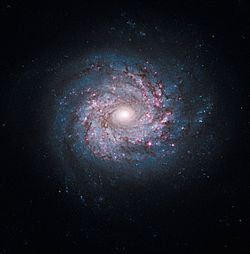- NGC 3982
-
NGC 3982 
Observation data (J2000 epoch) Constellation Ursa Major Right ascension 11h 56m 28.1s[1] Declination +55° 07′ 31″[1] Redshift 1109 ± 6 km/s[1] Distance 68.1 ± 2.5 Mly (20.89 ± 0.77 Mpc)[2] Type SAB(r)b[1] Apparent dimensions (V) 1′.7 × 1′.5[1] Apparent magnitude (V) 12.0[1] Other designations UGC 6918,[1]PGC 37520[1] See also: Galaxy, List of galaxies NGC 3982 is an intermediate spiral galaxy approximately 68 million light-years away in the constellation Ursa Major. It is also known as UGC 6918. It was discovered by William Herschel on April 14, 1789 and misclassified as planetary nebula.[3] NGC 3982 is a part of the M109 Group.
At an apparent magnitude of 12.0, NGC 3982 needs a telescope to be viewed. Using small telescopes, the galaxy appears as a very faint, diffuse patch of light with its central region appearing as a slightly brighter diffuse ball.
Contents
General
NGC 3982 is a Seyfert 2 galaxy that spans about 30,000 light-years, about one-third of the size of our Milky Way galaxy. The galaxy is receding from us at about 1109 km/s. The galaxy is a typical spiral galaxy, similar to our Milky Way. It harbors a supermassive black hole at its core and has massive regions of star formation in the bright blue knots in the spiral arms. Supernovae are likely to be found within these regions.
Star formation
NGC 3982 has a high rate of star birth within its arms, which are lined by pink star-forming regions of glowing hydrogen and newborn blue star clusters. Its bright nucleus is home to older populations of stars, which grow more densely packed toward the center. The galaxy also has active star formation in the circumnuclear region estimated at 0.52 M⊙/year. The HST image of NGC 3982 shows a mini-spiral between the circumnuclear star-forming region and the galaxy's nucleus, which could be the channel through which gas is transported to the supermassive black hole from the star-forming region.
Galaxy group information
NGC 3982 is a member of the M109 Group, a group of galaxies located in the constellation Ursa Major that may contain over 50 galaxies. The group was named after the brightest galaxy in the group, the spiral galaxy M109.[4][5][6]
Interest
Astronomers are interested in studying this galaxy as it can help in measuring extragalactic distances. It is helpful because it possesses two tools used to estimate astronomical distances: a stellar explosion, or supernova; and Cepheid variable stars.
Supernova 1998aq
In 1998, the light from a supernova in NGC 3982 (later called SN 1998aq) reached earth and was discovered by British amateur astronomer Mark Armstrong. It was discovered when it had an apparent magnitude of 14.9 and it had grown considerably brighter by two days after its initial sighting (it reached a maximum magnitude of 14.0). The explosion resulted from a binary system where a white dwarf star was capturing mass from its companion star. When the white dwarf had gathered enough mass and was no longer able to support itself, the star detonated in a violent and extremely bright explosion. Since a supernova explosion roughly occurs in a typical spiral galaxy every 100 years, astronomers use high-resolution images of NGC 3982 and other galaxies to detect stars which are nearing a similar explosive descent into supernovae.
See Also
- Messier 109
- M109 Group
- SN 1998aq
External links
- Spiral Galaxy NGC 3982 @ SEDS NGC objects pages
- The Distance to Supernova 1998aq in NGC3982 Arxiv, 2001
- NGC 3982 at ESA/Hubble
- Circumnuclear Star Forming Activity in NGC 3982
References
- ^ a b c d e f g h "NASA/IPAC Extragalactic Database". Results for NGC 3982. http://nedwww.ipac.caltech.edu/. Retrieved 2006-11-16.
- ^ Riess, Adam G.; Li, Weidong; Stetson, Peter B.; Filippenko, Alexei V.; Jha, Saurabh; Kirshner, Robert P.; Challis, Peter M.; Garnavich, Peter M.; Chornock, Ryan (2005). "Cepheid Calibrations from the Hubble Space Telescope of the Luminosity of Two Recent Type Ia Supernovae and a Redetermination of the Hubble Constant". Astrophysical Journal 627 (2): 579–607. arXiv:astro-ph/0503159. Bibcode 2005ApJ...627..579R. doi:10.1086/430497.
- ^ NGC 3982. Students for the Exploration and Development of Space. Retrieved March 3, 2009
- ^ R. B. Tully (1988). Nearby Galaxies Catalog. Cambridge: Cambridge University Press. ISBN 0-521-35299-1.
- ^ P. Fouque, E. Gourgoulhon, P. Chamaraux, G. Paturel (1992). "Groups of galaxies within 80 Mpc. II - The catalogue of groups and group members". Astronomy and Astrophysics Supplement 93: 211–233. Bibcode 1992A&AS...93..211F.
- ^ G. Giuricin, C. Marinoni, L. Ceriani, A. Pisani (2000). "Nearby Optical Galaxies: Selection of the Sample and Identification of Groups". Astrophysical Journal 543 (1): 178–194. arXiv:astro-ph/0001140. Bibcode 2000ApJ...543..178G. doi:10.1086/317070.
Categories:- Spiral galaxies
- Intermediate spiral galaxies
- M109 Group
- Ursa Major constellation
- NGC objects
- UGC objects
- PGC objects
Wikimedia Foundation. 2010.


